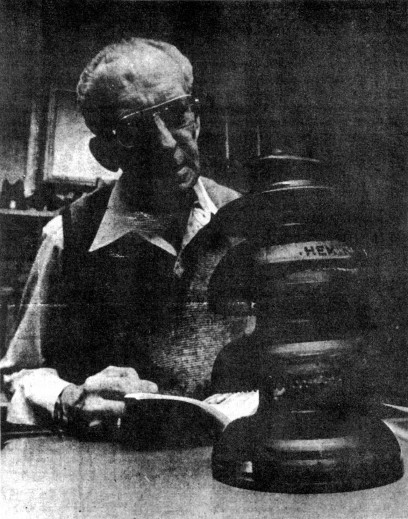Collector of the Month
Reprinted from "INSULATORS - Crown Jewels of the Wire", May 1978, page 18
William Hungate displays one of more than 500 insulators in his collection
which he started in 1968.
(The following article is copied from Herald and News, Klamath Falls, Oregon,
Sunday, February 5, 1978, and was written by Chris Beeson, with the title "Hungate
Is An Insulator Collector With Enthusiasm".)

(Photo by Owen Duvall)
One of the nation's most avid insulator collectors, William "Bill"
Hungate, 2520 Garden St., hopes to attend his first national convention this
year to share his enthusiasm with others involved in the hobby.
Hungate has been
doing his part to preserve electrical artifacts since July, 1968, collecting
more than 500 insulators of all types, colors and sizes. He was once contacted by a representative of the
Smithsonian Institute who was in the process of documenting the artifacts for
historical purposes.
Hungate, an employee of Southern Pacific Railroad since
1942, began his hobby by walking along railroad tracks picking up insulator
odds and ends.
"It began when my wife asked me why I didn't have a
hobby," he said. "Someone had given her a beautiful insulator and it
intrigued me."
Gaining a basic knowledge of insulators, Hungate took his
newly found hobby with him to work.
"I got my first by going along the
tracks and picking them up," he said. "They used to replace them and
just throw them down on the ground along the lines. You can still find them if
you look hard."
Telegraph, telephone and powerline insulators are the main
types, he said. "They were used to keep the flow of electricity going. In
our club, we are finding more types all the time -- wood, adobe, plastic, glazed
pottery and combinations of metal and glass."
The value of insulators is
steadily increasing as more and more utilities are turning to the use of
microwaves in power transmission. Price of insulators today ranges from $.50 for
a basic unit to $1,000 and more.
Hungate is a charter member of the National
Insulator Association, which now boasts a membership of 859.
"All over
the U.S. there are 1,500 or more serious collectors and probably hundreds more
we don't know about," Hungate stated. "A couple of years ago I read
that insulator collecting is one of the newest and fastest growing hobbies of
our time. It's ranked fourth behind stamps, coins and models."
Several of
Hungate's most prized insulators include an 1867 Brook's rams horn, which was
used on the transcontinental telegraph line which traveled West through Reno.
"It was found in Reno near the old Central Pacific Railroad
right-of-way," Hungate said. "It was discovered with the use of metal
detectors since the casing is metal and the core is glass."
Another
treasure is his Corning Pyrex insulator which weighs 38 pounds and was once used
on a 70,000-volt line. It is the largest single piece glass insulator ever
cast and is among part of his collection which is displayed at the Klamath
County Museum.
"The Corning insulator I own was used on a line in
Washington," he said. "Most of the ones in the country which still
remain may be found there. Some are still on the lines because it takes about
two men to get them down and they can only remove them when the power is
off."
Hungate's collection also includes various foreign insulators,
including one from Asmara, Ethiopia, the only one to be found in the United
States.
Insulators come in every color of the rainbow, said Hungate, except red.
"Red is hard to make because the color often separates and you get a red
and yellow split."
The National Insulator Association will hold its 9th
annual convention in Reno in July, the first convention to be held within
Hungate's grasp. "And Baby, I'll be there."
| 